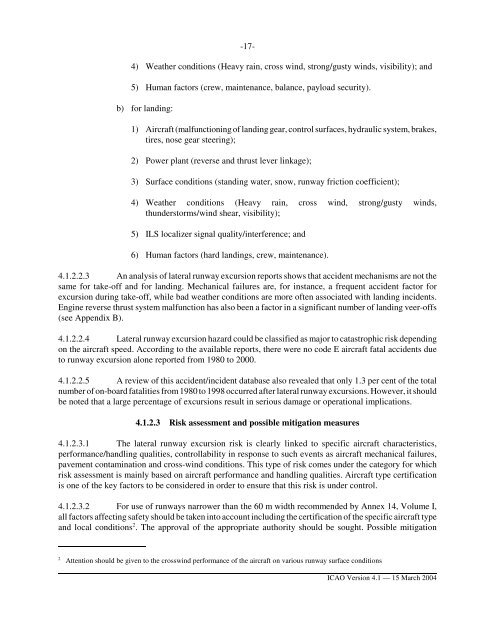Draft ICAO Circular on NLA.pdf - Airports Council International
Draft ICAO Circular on NLA.pdf - Airports Council International
Draft ICAO Circular on NLA.pdf - Airports Council International
Create successful ePaper yourself
Turn your PDF publications into a flip-book with our unique Google optimized e-Paper software.
-17-<br />
4) Weather c<strong>on</strong>diti<strong>on</strong>s (Heavy rain, cross wind, str<strong>on</strong>g/gusty winds, visibility); and<br />
5) Human factors (crew, maintenance, balance, payload security).<br />
b) for landing:<br />
1) Aircraft (malfuncti<strong>on</strong>ing of landing gear, c<strong>on</strong>trol surfaces, hydraulic system, brakes,<br />
tires, nose gear steering);<br />
2) Power plant (reverse and thrust lever linkage);<br />
3) Surface c<strong>on</strong>diti<strong>on</strong>s (standing water, snow, runway fricti<strong>on</strong> coefficient);<br />
4) Weather c<strong>on</strong>diti<strong>on</strong>s (Heavy rain, cross wind, str<strong>on</strong>g/gusty winds,<br />
thunderstorms/wind shear, visibility);<br />
5) ILS localizer signal quality/interference; and<br />
6) Human factors (hard landings, crew, maintenance).<br />
4.1.2.2.3 An analysis of lateral runway excursi<strong>on</strong> reports shows that accident mechanisms are not the<br />
same for take-off and for landing. Mechanical failures are, for instance, a frequent accident factor for<br />
excursi<strong>on</strong> during take-off, while bad weather c<strong>on</strong>diti<strong>on</strong>s are more often associated with landing incidents.<br />
Engine reverse thrust system malfuncti<strong>on</strong> has also been a factor in a significant number of landing veer-offs<br />
(see Appendix B).<br />
4.1.2.2.4 Lateral runway excursi<strong>on</strong> hazard could be classified as major to catastrophic risk depending<br />
<strong>on</strong> the aircraft speed. According to the available reports, there were no code E aircraft fatal accidents due<br />
to runway excursi<strong>on</strong> al<strong>on</strong>e reported from 1980 to 2000.<br />
4.1.2.2.5 A review of this accident/incident database also revealed that <strong>on</strong>ly 1.3 per cent of the total<br />
number of <strong>on</strong>-board fatalities from 1980 to 1998 occurred after lateral runway excursi<strong>on</strong>s. However, it should<br />
be noted that a large percentage of excursi<strong>on</strong>s result in serious damage or operati<strong>on</strong>al implicati<strong>on</strong>s.<br />
4.1.2.3 Risk assessment and possible mitigati<strong>on</strong> measures<br />
4.1.2.3.1 The lateral runway excursi<strong>on</strong> risk is clearly linked to specific aircraft characteristics,<br />
performance/handling qualities, c<strong>on</strong>trollability in resp<strong>on</strong>se to such events as aircraft mechanical failures,<br />
pavement c<strong>on</strong>taminati<strong>on</strong> and cross-wind c<strong>on</strong>diti<strong>on</strong>s. This type of risk comes under the category for which<br />
risk assessment is mainly based <strong>on</strong> aircraft performance and handling qualities. Aircraft type certificati<strong>on</strong><br />
is <strong>on</strong>e of the key factors to be c<strong>on</strong>sidered in order to ensure that this risk is under c<strong>on</strong>trol.<br />
4.1.2.3.2 For use of runways narrower than the 60 m width recommended by Annex 14, Volume I,<br />
all factors affecting safety should be taken into account including the certificati<strong>on</strong> of the specific aircraft type<br />
and local c<strong>on</strong>diti<strong>on</strong>s 2 . The approval of the appropriate authority should be sought. Possible mitigati<strong>on</strong><br />
2 Attenti<strong>on</strong> should be given to the crosswind performance of the aircraft <strong>on</strong> various runway surface c<strong>on</strong>diti<strong>on</strong>s<br />
<str<strong>on</strong>g>ICAO</str<strong>on</strong>g> Versi<strong>on</strong> 4.1 — 15 March 2004

















